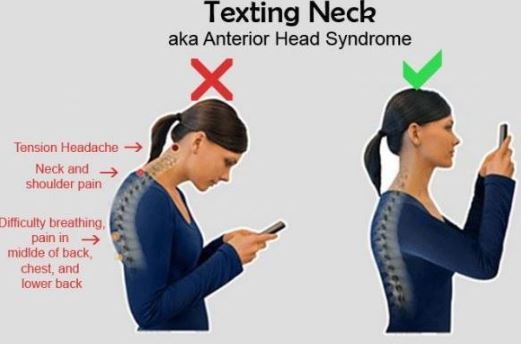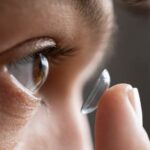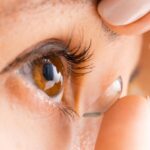Mobile Phones and Eyesight

The effects of mobile phones on the eyes are increasingly important in our technologically driven society. In this rapid evolution of technology, mobile phones have become integral to our daily lives, serving as indispensable tools for communication, schedule management, and information access. However, as we grow deeper into this technological era, it becomes crucial for us to pay closer attention to the effects of mobile phones on the eyes.
As per Statista’s data for 2023, the present count of global smartphone users stands at 6.92 billion, indicating that 85.74% of the world’s population possesses a smartphone. This represents a significant sharp increase from 2016 when the user base was 3.668 billion, constituting 49.40% of the global population at that time.
Mobile phones have changed a lot over time, from simple ones to the fancy smartphones we have now. The screens on these phones have become bigger and better. The screens on today’s smartphones are larger, have clearer images, and show more vibrant colours. While this makes using our phones more enjoyable, it also means we spend more time looking at the screens.
According to a BBC statistic, UK adults spend an average of 8 hours and 41 minutes a day on media devices, compared with the average night’s sleep of 8 hours and 21 minutes. This indicates our reliance on these devices
Despite the convenience and efficiency brought by smartphones, the effects they have on our eyes cannot be overlooked. This blog post throws more light on the relationship between mobile phones and our eye health, offering insights, solutions, and a glimpse into the future of eye-friendly technology.
How Mobile Phones Affect Eye Health
Computer Vision Syndrome
The use of mobile phones for longer periods contributes to digital eye strain, also known as Computer Vision Syndrome (CVS). Staring at the small text and bright screens of mobile phones for extended periods can lead to eyestrain, headaches, blurred vision, double vision and dry eyes. The eyes continuously adjust to the rapidly changing images on the screen, which requires repetitive muscle movements, leading to fatigue. Additionally, the small text size on mobile devices often requires users to squint (this is called, accommodation) or strain their eyes, further contributing to discomfort.
Blue Light Exposure
Mobile phone screens emit a type of light called blue light, and prolonged exposure to this light raises concerns for eye health. Blue light is part of the visible light spectrum, and it has a short wavelength and high energy. While exposure to natural blue light from the sun during daylight hours can have positive effects on mood and alertness, excessive exposure, especially from artificial sources like mobile phones, can lead to various issues.
The main worry is that prolonged exposure to blue light, particularly during evening hours, may disrupt the body’s natural circadian rhythm. This is because blue light suppresses the production of melatonin, a hormone that regulates sleep-wake cycles. Consequently, the use of mobile phones before bedtime might interfere with the ability to fall asleep and achieve restful sleep.
Moreover, some studies suggest a potential link between extended exposure to blue light and retinal damage. The eyes are not very effective at blocking blue light, and over time, this exposure may contribute to cumulative damage to the light-sensitive cells in the retina. However, further research is needed to establish a definitive connection between blue light from mobile phones and specific eye conditions.
Reduced Blinking Rate
When using mobile phones, people often blink less frequently, and this reduced blinking can have implications for eye health. Blinking is a natural and essential process that helps to moisten the eyes, spreading tears evenly across the surface and preventing them from drying out. The average adult blinks between 15 to 20 times per minute, however, when engrossed in mobile phone use, individuals tend to stare at the screen for prolonged periods without blinking enough.
The reduction in blinking during mobile phone use exacerbates the risk of dry eyes, particularly when combined with environmental factors like air conditioning or heating that can contribute to dryness. To address this concern, individuals may need to be mindful of their blinking habits and consciously make an effort to blink more frequently while using mobile devices.
Screen Glare and Reflections
Screen glare and reflections on mobile phone present potential hazards to eye health, particularly when using devices in bright or outdoor environments. Glare occurs when excessive, uncontrolled light reflects off the screen, making it challenging for users to see the display. This often results in users straining their eyes to overcome the visual interference caused by glare.
In outdoor settings, sunlight and other ambient light sources can create reflections on the screen, further complicating visibility. Users may adjust their viewing angles or squint to counteract these reflections, contributing to eye strain and discomfort. Prolonged exposure to glare may lead to fatigue, headaches, and diminished visual comfort.
The impact of screen glare and reflections is exacerbated when using mobile devices for extended periods, as users may not be aware of the gradual strain on their eyes. To eliminate these issues, individuals often resort to unusual and uncomfortable viewing positions or adjust the brightness settings on their devices. Managing screen glare is crucial for maintaining good eye comfort and reducing the risk of discomfort and visual fatigue associated with prolonged mobile phone use in different lighting environments.
Texting and Reading Habits
The way people text and read on mobile phones can affect their eyes. Mobile devices usually have small screens which make users strain their eyes to read tiny text. Holding the phone too close or at awkward angles can contribute to discomfort and visual fatigue. The habit of focusing on the small screen for extended periods can lead to eyestrain, where the eye muscles work harder than usual.
Small font sizes can necessitate squinting or intense focusing to see, these can cause headaches and blurred vision. The consistent demand on the eyes to maintain focus on a compact display may contribute to overall eye fatigue.
These habits are further pronounced in situations where individuals use their phones extensively for work, education, or leisure. The strain on the eyes resulting from prolonged reading or texting sessions underscores the importance of adopting practices that prioritize eye comfort and reduce the risk of discomfort associated with mobile phone use.
Posture Issues

One of the effects of mobile phones on the eyes is posture issues. How people position themselves while holding their mobile phones can have some consequences on eye health. One common posture issue arises when individuals spend extended periods looking down at their phones. This downward gaze, often referred to as “text neck”, “tech neck” or “anterior head syndrome” can contribute to neck and shoulder strain which can indirectly affect our eyes.
The frequent use of mobile phones for various activities like browsing, social media, and texting requires that people position their phones at a lower level, maintaining a downward gaze. It can lead to an unnatural curvature of the spine, causing stress on the neck and shoulders. This strain may extend to the eyes, as the muscles and structures supporting vision are interconnected with those of the neck and upper back. Over time, maintaining this posture can result in discomfort, headaches, and a feeling of heaviness in the eyes. Addressing posture issues is essential to reduce the risk of musculoskeletal strain and promote overall eye comfort during and after mobile phone use.
The way Out
The 20-20-20 Rule
The 20-20-20 rule is a simple and effective rule to reduce eye strain and fatigue caused by prolonged screen use. The rule requires that you take a break every 20 minutes, during which you should shift your focus away from the screen and look at an object located at least 20 feet away for about 20 seconds or more.
The rationale behind the 20-20-20 rule is to give your eyes a brief rest from the constant strain of staring at a screen up close. Prolonged screen time, especially on mobile phones, can cause eye muscles to become fatigued, leading to symptoms such as eyestrain, headaches, and dry eyes.
By following the 20-20-20 rule, you allow your eye muscles to relax and readjust to a different focal length. Looking at a distant object also encourages blinking, which helps moisten the eyes and prevent dryness. This practice promotes better eye health and reduces the risk of developing digital eye strain or Computer Vision Syndrome associated with extended screen use.
Position yourself well
Hold your phone at about eye level to reduce the strain on your eyes and neck. This helps maintain a more natural and comfortable viewing angle. Use the guide below to determine how far away from your eyes that you need to hold your gadgets for comfortable use:
- 4.5-inch Phone = 15cm away from eyes
- 5.5 – 6.3 inch Phone = 23cm away from eyes
- 7-inch Tablet = 30 – 33cm away from Eyes
- 10-inch iPad = 40cm away from eyes
- 13-inch iPad/Laptop = 63cm inch away from eyes
- 21-inch Desktop = 83cm away from eyes
You can also invest in an adjustable phone stand or holder that allows you to position your phone at eye level
Optimal Settings
- Adjust the brightness settings on your phone to match the ambient lighting conditions in your immediate environment and make sure your environment is well illuminated.
- Consider using anti-glare screen protectors to minimize reflections and glare.
- Adjust the font size on your phone to make text more readable.
Eyewear
You can purchase a Blue Block Lens to help with your exposure to high-energy visible (HEV) blue light which contributes to the effects of mobile phones on eyes. Though the scientific evidence supporting the effectiveness of blue light-blocking lenses is a topic of ongoing research, and the conclusions are not universally agreed upon it is still better to get them and prevent any damage than to be sorry.




